Introduction:
Atelectasis is a condition characterized by the partial or complete collapse of a lung or a lobe of a lung. It often occurs after surgery, especially in patients who have undergone general anesthesia. Understanding the causes, symptoms, and treatment of atelectasis is crucial for managing this condition effectively, especially in post-operative care.

Causes of Atelectasis:
Atelectasis can occur due to various reasons, but after surgery, there are specific factors that contribute to its development. One of the primary causes is the use of general anesthesia, which can lead to a decrease in the cough reflex and shallow breathing. This, in turn, can result in the accumulation of mucus in the airways, leading to blockage and collapse of the lung tissue.
Other factors that can contribute to the development of atelectasis after surgery include:
Inadequate breathing:
Pain and discomfort after surgery can make it difficult for patients to take deep breaths, leading to shallow breathing and inadequate expansion of the lungs.
Immobility:
Patients who are bedridden or immobile after surgery are at a higher risk of developing atelectasis due to reduced movement of the chest wall and decreased ventilation of the lungs.
Lung conditions:
Pre-existing lung conditions such as chronic obstructive pulmonary disease (COPD) or asthma can increase the risk of developing atelectasis after surgery.
Smoking:
Smoking can damage the airways and impair the function of the cilia, which are responsible for clearing mucus from the airways, increasing the risk of mucus accumulation and atelectasis.
Symptoms of Atelectasis:
The symptoms of atelectasis can vary depending on the severity and extent of lung collapse. Common symptoms include:
Shortness of breath:
Patients may experience difficulty breathing, especially during physical activity or exertion.
Chest pain:
Chest pain may occur, particularly on the side of the collapsed lung.
Cough:
A dry or productive cough may be present, along with the production of thick, yellow or green mucus.
Fever:
In some cases, atelectasis can lead to a low-grade fever, indicating an underlying infection.
Bluish skin or lips:
In severe cases, lack of oxygen due to atelectasis can cause cyanosis, a bluish discoloration of the skin and lips.
Treatment of Atelectasis:
The treatment of atelectasis after surgery aims to re-expand the collapsed lung tissue and improve lung function. Treatment options may include:
Incentive spirometry:
This breathing exercise involves using a device to help patients take deep breaths, which can help re-expand the collapsed lung tissue.
Chest physiotherapy:
This technique involves chest percussion and postural drainage to help loosen and remove mucus from the airways, reducing the risk of further lung collapse.
Bronchoscopy:
In some cases, a bronchoscopy may be performed to remove mucus or foreign objects blocking the airways and causing atelectasis.
Oxygen therapy:
Supplemental oxygen may be provided to ensure that the body receives an adequate supply of oxygen, especially in cases of severe atelectasis.
Medications:
In cases where atelectasis is caused by an underlying infection, antibiotics may be prescribed to treat the infection and reduce inflammation in the lungs.
Prevention of Atelectasis:
Preventing atelectasis after surgery is key to reducing the risk of complications. Some preventive measures include:
Early mobilization:
Encouraging patients to move and walk as soon as possible after surgery can help prevent atelectasis by improving lung function and clearing mucus from the airways.
Deep breathing exercises:
Teaching patients deep breathing exercises, such as diaphragmatic breathing, can help improve lung function and prevent atelectasis.
Smoking cessation:
Advising patients to quit smoking before surgery can help reduce the risk of developing atelectasis and other post-operative complications.
Adequate pain management:
Providing adequate pain relief after surgery can help patients breathe more comfortably and reduce the risk of shallow breathing and atelectasis.
Conclusion:
Atelectasis is a common complication that can occur after surgery, especially in patients who have undergone general anesthesia. Understanding the causes, symptoms, and treatment of atelectasis is essential for healthcare providers to provide appropriate care and prevent complications. By implementing preventive measures and early intervention, the risk of atelectasis can be reduced, leading to better outcomes for patients undergoing surgery.
| Older Post | Home | Newer Post |


